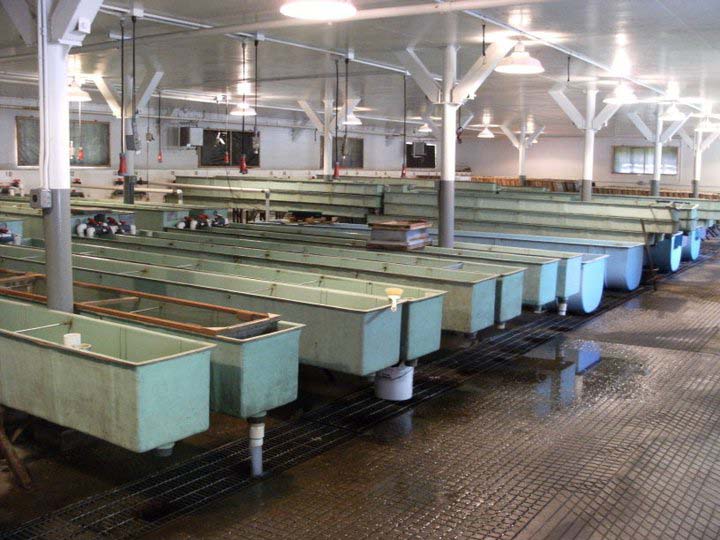forum
library
tutorial
contact

NOAA Fisheries Stipulates No Mitchell Act Funds
for 10 Hatcheries Until Hatchery BiOp Completed
by Staff
Columbia Basin Bulletin, September 9, 2016
|
the film forum library tutorial contact |

|
NOAA Fisheries Stipulates No Mitchell Act Funds
by Staff
|
"... Hatchery fish suppress the productivity of wild populations, prey on wild fish,
compete with them for resources, and introduce disease and pathogens."
 NOAA Fisheries and the Wild Fish Conservancy have stipulated that the agency will not disburse Mitchell Act funds to 10 Northwest hatcheries until the federal agency has completed its hatchery biological opinion and incidental take statements for the disbursements.
NOAA Fisheries and the Wild Fish Conservancy have stipulated that the agency will not disburse Mitchell Act funds to 10 Northwest hatcheries until the federal agency has completed its hatchery biological opinion and incidental take statements for the disbursements.
NOAA Fisheries estimated the BiOp and incidental take statement will be completed between October 1 and December 1, 2016.
The stipulation was reached August 2 in Oregon U.S. District Court in the Wild Fish Conservancy vs National Marine Fisheries Service court case that began March 31, 2016.
The original March 31 filing can be found at: wildfishconservancy.org/copy_of_news/in-the-news/001.0.complaintMitchellActColumbia33116.pdf
In the case, the conservancy contends Mitchell Act funds were intended to support hatchery operations that help rather than harm wild fish populations.
Prior to the stipulation, the Conservancy had filed July 13 a complaint seeking an injunction and restraining order to stop the funding, which signaled an effort on the part of plaintiffs to accelerate the proceedings.
The filing for an injunction and restraining order can be found at wildfishconservancy.org/copy_of_news/in-the-news/014.00.mpreliminary.injunctionMitchellAct.pdf
In that filing, the Conservancy said:
"High proportions of hatchery fish straying onto spawning grounds pose severe genetic risks to the productivity of wild fish. The best available science confirms that stray rates -- measured as the proportion of hatchery-origin spawners within a naturally spawning population, or pHOS" -- in excess of 5% or 10% seriously harm the fitness of wild fish, making hatcheries a primary limiting factor to recovery. Hatchery fish suppress the productivity of wild populations, prey on wild fish, compete with them for resources, and introduce disease and pathogens."Over 26.4 million hatchery lower Columbia River fall chinook smolts will be released in the Columbia River basin, according to the complaint.
In addition, some 24 of the 27 lower Columbia River coho salmon evolutionary significant units are at risk, it said.
Oral arguments on the case that were scheduled for Oct. 3 in a Portland courtroom before Chief Judge Michael W. Mosman have been canceled. Judge Mosman instead will require a status report on the litigation on Oct. 3.
 The lower Columbia River fall chinook hatchery programs subject to the restraining order and injunction request include:
The lower Columbia River fall chinook hatchery programs subject to the restraining order and injunction request include:
It charged that NOAA Fisheries has not consulted with the public and cooperating agencies, as required under the ESA, since the first required consultation was conducted in 1999, and that programs funded under the Mitchell Act "are jeopardizing the continued existence of salmonids."
Since that 1999 consultation, eight salmon species protected under the ESA have been harmed by NMFS's hatchery programs, the complaint claims, including the Lower Columbia River chinook and coho salmon that the litigation seeks to protect.
While some lower Columbia River chinook populations once included as many as 22,000 to 27,000 wild fish, none currently have more than about 500 wild fish and 14 of the 21 populations contain fewer than 50 wild fish, says the complaint.
The Conservancy pointed out that Congress enacted the Mitchell Act in 1938 in effort to mitigate adverse effects to wild salmon in the Columbia River Basin from the construction of dams, water diversions, logging, and pollution.
The Conservancy said that the suit narrowly focuses on NOAA Fisheries' funding of ten hatchery programs operated on behalf of the federal agency by ODFW and WDFW "that harm" lower Columbia River chinook and coho salmon.
Those hatchery programs funded under the Mitchell Act "adversely affect" species listed under the federal Endangered Species Act "in a variety of ways, including facility effects, fish removal activities, genetic and ecological interactions, fishery effects, and monitoring and evaluation."
For these reasons, the Conservancy says, NOAA Fisheries is required to consult under section 7(a)(2) of the ESA.
Once the BiOp and incidental take are complete, the Conservancy will have 14 days to either file a motion "to supplement and/or amend its complaint or provide the Court and Federal Defendants notice that Plaintiff does not seek to supplement and/or amend the complaint at that time," the stipulation said.
Related Pages:
No Mitchell Act Funding Until Hatchery BiOp Completed by Laura Berg, NW Fishletter, 9/1/16
Wild Fish Conservancy Files Lawsuit To Force Federal Consultation On Basin Mitchell Act Hatcheries by Staff, Columbia Basin Bulletin, 4/1/16
Wild Fish Conservancy Takes Legal Aim at Hatchery Funding by Steve Ernst, NW Fishletter, 2/1/16
Wild Fish Advocates File Notice Against Mitchell Act Hatcheries, 60 Million Smolts Annually by Staff, Columbia Basin Bulletin, 1/15/16
Related Pages:
Wild Fish Conservancy Seeks Injunction To Block Use Of Mitchell Act Funds For Basin Hatcheries by Staff, Columbia Basin Bulletin, 8/5/16
learn more on topics covered in the film
see the video
read the script
learn the songs
discussion forum
